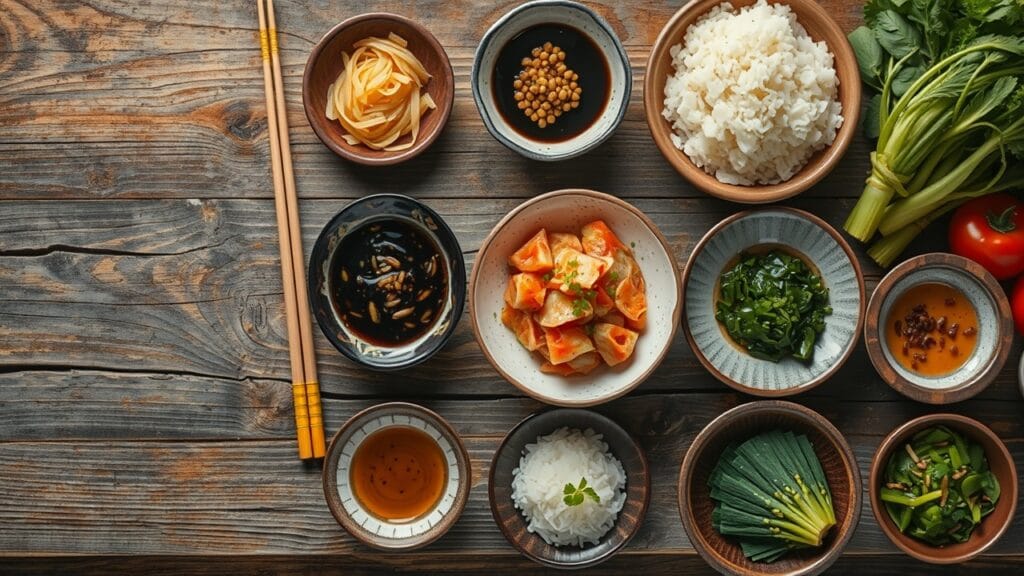Japanese cuisine is a delightful blend of tradition, artistry, and flavor, all packaged in recipes that can be as simple or intricate as you wish. From vibrant sushi rolls to warm bowls of ramen, Japanese dishes have captured the hearts (and stomachs) of people worldwide. The best part? You don’t need professional culinary skills or rare ingredients to recreate these dishes at home. This guide will teach you everything you need to know about easy Japanese recipes, the essential ingredients, and tips to make your cooking journey enjoyable.
Introduction to Easy Japanese Recipes
The beauty of Japanese cuisine lies in its simplicity. While dishes like sushi and tempura might appear elaborate, many recipes rely on a handful of basic ingredients and simple techniques. Whether you’re a beginner or a seasoned home cook, there’s a Japanese recipe to suit your skill level and palate.
Cooking Japanese food at home allows you to immerse yourself in the country’s rich culinary culture while also tailoring dishes to your preferences. Fancy a spicy ramen or an extra layer of teriyaki glaze? It’s all in your hands!
Benefits of Cooking Japanese Recipes at Home
Cooking Japanese dishes at home is more than just preparing meals—it’s a rewarding experience with numerous benefits. Let’s explore why you should give it a try:
Healthy and Nutritious Meals
Japanese cuisine is widely regarded as one of the healthiest in the world. Dishes often focus on fresh, seasonal ingredients like vegetables, fish, and rice. For instance, miso soup and grilled salmon are packed with nutrients while being light and easy to digest.
- Rich in Nutrients: The inclusion of seaweed, tofu, and fermented ingredients boosts gut health.
- Low in Calories: Japanese meals prioritize balance and portion control, making them perfect for a healthy lifestyle.
By cooking at home, you can further control the ingredients and adjust the recipes to suit your dietary needs.
Budget-Friendly Options
Enjoying Japanese cuisine at restaurants can quickly add up, especially when dining out regularly. However, preparing these dishes at home is surprisingly affordable.
Example Costs:
- A bottle of soy sauce: ~$4 (lasts for months)
- A bag of sushi rice: ~$6 (makes several servings)
- Miso paste: ~$5 (essential for soups and dressings)
With a well-stocked pantry, you can make multiple dishes without frequently buying specialty ingredients.
“Cooking Japanese food at home is like opening the door to a world of flavors without the hefty restaurant bill.”
Essential Japanese Ingredients for Beginners
Before diving into recipes, it’s important to stock up on key ingredients that form the backbone of Japanese cuisine. Don’t worry—most of these are easy to find in supermarkets or online.
Pantry Staples
Here’s a list of must-have pantry items for Japanese cooking:
- Soy Sauce: Adds a savory, umami-rich flavor to dishes.
- Miso Paste: The base for soups, marinades, and even salad dressings.
- Rice Vinegar: Provides a tangy flavor, especially in sushi rice.
- Dashi: A traditional soup stock made from kombu (kelp) and bonito flakes.
- Sesame Oil: For a nutty aroma in stir-fries and salads.
- Seaweed (Nori/Kombu): Used in soups, sushi, and garnishes.
Fresh Ingredients
Japanese cooking emphasizes fresh and seasonal produce. Some common items include:
- Rice: Short-grain or sushi rice is a must.
- Vegetables: Green onions, daikon radish, mushrooms (shiitake or enoki), and cucumbers.
- Proteins: Salmon, chicken, shrimp, or tofu for a vegetarian twist.
- Eggs: A key component in dishes like tamago (Japanese omelet) and ramen toppings.
Must-Have Tools for Japanese Cooking
You don’t need a fancy kitchen setup to cook Japanese dishes. Most of the tools you already own are sufficient, but here are a few that make the process easier:
Basic Kitchen Tools
- Sharp Knife: For precise slicing of fish, vegetables, and meats.
- Cutting Board: A sturdy surface for preparing ingredients.
- Rice Cooker: Perfectly cooked rice is a cornerstone of Japanese meals.
Specialty Tools for Authenticity
- Bamboo Sushi Mat: Essential for rolling sushi.
- Mandoline Slicer: For paper-thin cuts of vegetables.
- Miso Strainer: Ensures smooth miso soup without lumps.
Quick and Easy Japanese Recipes to Try Today
Now, let’s dive into the heart of this guide—recipes! These dishes are simple, quick, and full of authentic Japanese flavors.
1. Classic Miso Soup
Ingredients:
- 4 cups dashi broth
- 3 tbsp miso paste
- 1/2 cup cubed tofu
- 1 sheet wakame seaweed (soaked)
- Sliced green onions
Steps:
- Heat dashi broth in a pot (do not boil).
- Dissolve miso paste using a ladle.
- Add tofu and seaweed, cook for 2 minutes.
- Garnish with green onions. Serve warm.
Ready in just 10 minutes, miso soup is a comforting start to any meal!
2. Teriyaki Chicken
Ingredients:
- 2 chicken thighs (boneless)
- 1/4 cup soy sauce
- 2 tbsp mirin
- 1 tbsp sugar
- 1 tbsp sesame oil
Steps:
- Heat sesame oil in a pan and sear chicken.
- Mix soy sauce, mirin, and sugar, then pour over chicken.
- Simmer until sauce thickens and coats the chicken.
- Serve with steamed rice and vegetables.
3. Udon Noodle Stir-Fry
Ingredients:
- Fresh udon noodles
- Mixed vegetables (carrots, bell peppers, cabbage)
- Soy sauce, oyster sauce, and sesame oil
Steps:
- Stir-fry vegetables in sesame oil.
- Add cooked udon noodles and sauces.
- Toss everything until evenly coated.
“A quick stir-fry that’s perfect for busy weeknights!”
Common Challenges in Japanese Cooking and How to Solve Them
Cooking Japanese food can come with its challenges, especially if you’re new to the cuisine. Here’s how to tackle common issues:
Finding Ingredients Locally
- Solution: Shop online for hard-to-find items like bonito flakes or specialty rice. Look for Asian grocery stores in your area.
- Substitutions: Replace mirin with a mix of white wine and sugar. Use spinach as a substitute for seaweed.
Balancing Flavors
Japanese cuisine is all about harmony. If your dish feels too salty, balance it with a touch of sugar or rice vinegar. Experimenting is key!
“Think of Japanese cooking as a symphony where every flavor—sweet, salty, sour, and umami—plays its part.”
Advanced Japanese Cooking Techniques for Enthusiasts
Once you’ve mastered the basics, it’s time to elevate your skills by exploring advanced techniques that will bring authenticity and finesse to your Japanese cooking. These methods not only deepen your appreciation for the cuisine but also allow you to craft restaurant-quality dishes at home.
Mastering Sushi Rolls
Sushi rolling might seem daunting, but it’s an art worth learning. Start with simple rolls, such as cucumber or avocado maki, before moving to more complex options like dragon rolls or sushi with raw fish.
Pro Tips for Perfect Sushi Rolls:
- Perfect Rice: Sushi rice should be sticky yet firm. Mix cooked short-grain rice with seasoned rice vinegar for the ideal texture.
- Proper Rolling Technique: Place nori (seaweed) shiny side down on a bamboo sushi mat. Layer with rice, fillings, and roll tightly using the mat.
- Wet Hands: Keep your hands slightly wet to prevent rice from sticking.
Tempura Perfection
Tempura, a light and crispy Japanese dish, is a favorite worldwide. Achieving the perfect tempura batter requires attention to detail.
Tips for Perfect Tempura:
- Use ice-cold water in the batter to keep it airy and light.
- Avoid overmixing; a few lumps in the batter are fine.
- Maintain the oil temperature at around 340–360°F (170–180°C). Fry in small batches to avoid cooling the oil.
Common ingredients for tempura include shrimp, sweet potatoes, zucchini, and mushrooms. Serve with a dipping sauce made from soy sauce, dashi, and mirin for an authentic touch.
Making Ramen Broth from Scratch
While instant ramen is convenient, making ramen broth from scratch takes your dish to the next level. This slow-cooked broth can be made from pork bones (tonkotsu), chicken (shoyu or shio), or vegetables.
Steps to Make Ramen Broth:
- Simmer pork bones, chicken carcasses, or vegetables with garlic, ginger, and scallions for several hours.
- Skim the foam occasionally to achieve a clear broth.
- Add soy sauce or miso paste for seasoning.
Pair your broth with fresh ramen noodles, a soft-boiled egg, and toppings like nori, bamboo shoots, and green onions.
Hosting a Japanese-Themed Dinner Party
Hosting a Japanese-themed dinner party is a fun and interactive way to share your newfound skills with friends and family. Here’s how to create an unforgettable experience:
Suggested Menu
- Appetizer:
- Edamame sprinkled with sea salt
- Miso soup
- Main Course:
- Teriyaki chicken
- Vegetable tempura
- Side Dish:
- Onigiri (rice balls with fillings like salmon or pickled plum)
- California rolls
- Dessert:
- Matcha green tea ice cream
- Mochi
Table Décor and Presentation
- Use traditional Japanese table settings, such as small bowls and chopsticks.
- Decorate with cherry blossom motifs or origami cranes for an authentic touch.
- Play soft Japanese instrumental music in the background to enhance the ambiance.
Exploring Regional Japanese Cuisine

Japan’s culinary landscape is incredibly diverse, with each region boasting its own specialties. Here are a few examples to inspire your cooking:
Hokkaido
Known for its fresh seafood, dairy products, and hearty soups, Hokkaido cuisine is perfect for cold weather. Try dishes like Sapporo-style miso ramen or butter corn seafood soup.
Kyoto
Kyoto is renowned for its refined kaiseki cuisine, which consists of a multi-course meal showcasing seasonal ingredients. Simple yet elegant dishes like yudofu (tofu hot pot) and matcha desserts highlight Kyoto’s culinary traditions.
Osaka
Osaka is often called Japan’s kitchen, famous for street foods like takoyaki (octopus balls) and okonomiyaki (savory pancakes). These dishes are flavorful, hearty, and easy to recreate at home.
Celebrating Japanese Desserts: A Sweet Finale
No Japanese meal is complete without indulging in traditional desserts. Japanese sweets often balance subtle sweetness with unique textures and flavors.
Matcha Green Tea Ice Cream
Ingredients:
- 2 cups heavy cream
- 1 cup whole milk
- 3 tbsp matcha powder
- 1/2 cup sugar
Steps:
- Whisk matcha powder with warm milk until smooth.
- Combine with cream and sugar, then churn in an ice cream maker.
- Freeze for a few hours before serving.
Mochi: The Chewy Delight
Mochi, made from glutinous rice, is a versatile dessert that can be filled with sweet red bean paste, chocolate, or fresh fruit.
Pro Tip: Dust your hands with cornstarch or potato starch to prevent sticking while shaping the mochi.
Dorayaki Pancakes
These fluffy pancakes, filled with sweet azuki bean paste, are a popular treat. You can also experiment with fillings like Nutella or custard for a modern twist.
Final Tips for Making Japanese Cooking Even Easier
Cooking Japanese food at home is a journey that becomes more enjoyable with practice. Here are some tips to simplify the process:
- Prep in Advance: Chop vegetables, marinate proteins, and prepare sauces ahead of time to save effort during busy evenings.
- Use Substitutions: Don’t stress if you’re missing an ingredient. Substitutions like chicken broth for dashi or lemon juice for rice vinegar work well in a pinch.
- Experiment: Once you’re comfortable with the basics, tweak recipes to suit your tastes. Add a splash of spice to your ramen or extra sweetness to your teriyaki sauce.
Conclusion: Bring Japan to Your Kitchen
Cooking Japanese food at home is not just about creating meals; it’s about exploring a new culture, experimenting with flavors, and enjoying the process. Whether you’re preparing a simple bowl of miso soup or hosting a Japanese-themed dinner party, this guide equips you with everything you need to succeed.
From beginner-friendly recipes to advanced techniques and regional inspirations, Japanese cuisine offers endless possibilities. So grab your soy sauce, roll up your sleeves, and embark on a culinary adventure that brings the authentic taste of Japan to your kitchen.
“Cooking is an act of love. Embrace the art, savor the flavors, and enjoy the journey!”

